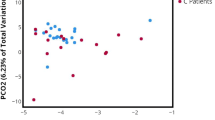Abstract
Introduction and hypothesis
This study was designed to detect whether nanobacteria (NB) reside in urine and bladder tissue samples of patients with interstitial cystitis/painful bladder syndrome (IC/PBS) and whether antibiotic therapy targeting these organisms is effective in reducing NB levels and IC/PBS symptoms.
Methods
Twenty-seven IC/PBS patients underwent cystoscopy. Bladder biopsies and urine samples were obtained and cultured for NB, which were identified by indirect immunofluorescent staining and transmission electron microscopy.
Results
Eleven bladder samples showed growth of microbes that were identified to be similar to NB. Homologous study of the 16S ribosomal RNA gene suggested that the NB could be the pathogen. For enrolled 11 patients, NB levels decreased dramatically after tetracycline treatment, and they reported significant reduction in the severity of IC/PBS symptoms.
Conclusions
A high prevalence of NB was observed in female IC/PBS, and anti-NB treatment effectively improved the symptoms, which suggest that NB may cause some cases of IC/PBS.



Similar content being viewed by others
References
Erickson DR, Tomaszewski JE, Kunselman AR et al (2008) Urine markers do not predict biopsy findings or presence of bladder ulcers in interstitial cystitis/painful bladder syndrome. J Urol 179:1850–1856
Butrick CW, Sanford D, Hou Q, Mahnken JD (2009) Chronic pelvic pain syndromes: clinical, urodynamic, and urothelial observations. Int Urogynecol J Pelvic Floor Dysfunct 20:1047–1053
Domingue GJ, Ghoniem GM, Bost KL, Fermin C, Human LG (1995) Dormant microbes in interstitial cystitis. J Urol 153:1321–1326
Keay S, Schwalbe RS, Trifillis AL, Lovchik JC, Jacobs S, Warren JW (1995) A prospective study of microorganisms in urine and bladder biopsies from interstitial cystitis patients and controls. Urology 45:223–229
Bratos-Pérez MA, Sánchez PL, García de Cruz S et al (2008) Association between self-replicating calcifying nanoparticles and aortic stenosis: a possible link to valve calcification. Eur Heart J 29:371–376
Ciftcioglu N, Kajander EO (1998) Interaction of nanobacteria with cultured mammalian cells. Pathophysiology 4:259–270
Kajander EO, Ciftcioglu N (1998) Nanobacteria: an alternative mechanism for pathogenic intra- and extracellular calcification and stone formation. Proc Natl Acad Sci U S A 95:8274–8279
Ciftçioglu N, Björklund M, Kuorikoski K, Bergström K, Kajander EO (1999) Nanobacteria: an infectious cause for kidney stone formation. Kidney Int 56:1893–1898
Zhou Z, Hong L, Shen X et al (2008) Detection of nanobacteria infection in type III prostatitis. Urology 71:1091–1095
Wood HM, Shoskes DA (2006) The role of nanobacteria in urologic disease. World J Urol 24:51–54
Warren JW, Horne LM, Hebel JR, Marvel RP, Keay SK, Chai TC (2000) Pilot study of sequential oral antibiotics for the treatment of interstitial cystitis. J Urol 163:1685–1688
Burkhard FC, Blick N, Hochreiter WW, Studer UE (2004) Urinary urgency and frequency, and chronic urethral and/or pelvic pain in females. Can doxycycline help? J Urol 172:232–235
Cíftçíoglu N, Miller-Hjelle MA, Hjelle JT, Kajander EO (2002) Inhibition of nanobacteria by antimicrobial drugs as measured by a modified microdilution method. Antimicrob Agents Chemother 46:2077–2086
Gillenwater JY, Wein AJ (1988) Summary of the National Institute of Arthritis, Diabetes, Digestive and Kidney Diseases Workshop on Interstitial Cystitis, National Institutes of Health, Bethesda, Maryland, August 28–29, 1987. J Urol 140:203–206
Drancourt M, Berger P, Raoult D (2004) Systematic 16S rRNA gene sequencing of atypical clinical isolates identified 27 new bacterial species associated with humans. J Clin Microbiol 42:2197–2202
Shoskes DA, Thomas KD, Gomez E (2005) Anti-nanobacterial therapy for men with chronic prostatitis/chronic pelvic pain syndrome and prostatic stones: preliminary experience. J Urol 173:474–477
Kushner L, Moldwin RM (2006) Efficiency of questionnaires used to screen for interstitial cystitis. J Urol 176:587–592
Drancourt M, Jacomo V, Lepidi H et al (2003) Attempted isolation of Nanobacterium sp. microorganisms from upper urinary tract stones. J Clin Microbiol 41:368–372
Benzerara K, Miller VM, Barell G et al (2006) Search for microbial signatures within human and microbial calcifications using soft x-ray spectromicroscopy. J Investig Med 54:367–379
Martel J, Young JD (2008) Purported nanobacteria in human blood as calcium carbonate nanoparticles. Proc Natl Acad Sci U S A 105:5549–5554
Raoult D, Drancourt M, Azza S et al (2008) Nanobacteria are mineralo fetuin complexes. PLoS Pathog 4:e41
Young JD, Martel J, Young D et al (2009) Characterization of granulations of calcium and apatite in serum as pleomorphic mineralo-protein complexes and as precursors of putative nanobacteria. PLoS One 4:e5421
Prusiner SB (1997) Prion diseases and the BSE crisis. Science 278:245–251
Ciftcioglu N, Aho KM, McKay DS, Kajander EO (2007) Are apatite nanoparticles safe? Lancet 369:2078
Hjelle JT, Miller-Hjelle MA, Poxton IR et al (2000) Endotoxin and nanobacteria in polycystic kidney disease. Kidney Int 57:2360–2374
Ciftçioğlu N, Ds McKay, Kajander EO (2003) Association between nanobacteria and periodontal disease. Circulation 108:e58–59
Tsurumoto T, Zhu D, Sommer AP (2008) Identification of nanobacteria in human arthritic synovial fluid by method validated in human blood and urine using 200 nm model nanoparticles. Environ Sci Technol 42:3324–3328
Eisen DP, Fraser IR, Sung LM, Finlay M, Bowden S, O’Connell H (2009) Decreased viral load and symptoms of polyomavirus-associated chronic interstitial cystitis after intravesical cidofovir treatment. Clin Infect Dis 48:e86–88
Kajander EO, Ciftcioglu N, Miller-Hjelle MA, Hjelle JT (2001) Nanobacteria: controversial pathogens in nephrolithiasis and polycystic kidney disease. Curr Opin Nephrol Hypertens 10:445–452
Little EM, Holt C (2004) An equilibrium thermodynamic model of the sequestration of calcium phosphate by casein phosphopeptides. Eur Biophys J 33:435–447
Acknowledgments
This study was supported by the National Natural Science Foundation of China no. 30700270 and no.30772161.
Conflicts of interest
None.
Author information
Authors and Affiliations
Corresponding authors
Additional information
Qing-hua Zhang and Xue-cheng Shen contributed equally to the study.
Rights and permissions
About this article
Cite this article
Zhang, Qh., Shen, Xc., Zhou, Zs. et al. Decreased nanobacteria levels and symptoms of nanobacteria-associated interstitial cystitis/painful bladder syndrome after tetracycline treatment. Int Urogynecol J 21, 103–109 (2010). https://doi.org/10.1007/s00192-009-0994-7
Received:
Accepted:
Published:
Issue Date:
DOI: https://doi.org/10.1007/s00192-009-0994-7




